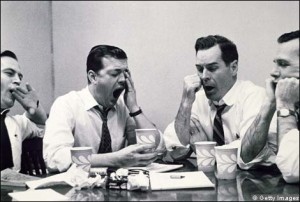YAWNING
XII. Integration of Yawn Circuitry and Behavior
A. Basic Linear Circit: Input Þ Output
1. Sensory Inputs
a. Eyes-RGCs-Glu Þ RHT Þ SCN core
b. SCN core ó SCN shell
c. SCN shell Þ AVP Þñ V1A PVN
2. Modulation / Gating Nuclei
a. AVP Þñ V1A PVN Þñ OT
b. PVN Þñ OT Þñ OT-R NST
3. Efferent Outputs
a. NST Þñ Glu Þñ AMPA/NMDA CCC8-T2
i. CCC8-T2 = Ciliospinal Center in C8-T2 spinal cord
ii. CCC8-T2 = sympathetic NS preganlionic cell bodies
b. CCC8-T2 Þñ ACh Þñ Nicotinic-R SCGÞ hypoglossal nerve
i. SCG = Superior Cervical Ganglion
ii. SCG = sympathetic NS postganlionic cell bodies
iii. hypoglossal nerve contains some postganlionic axons
c. SCG Þñ NE Þñ a1-Gp/Ca++ & b2-Gs/cAMP Þñ ACh release
i. ACh released from geniohyoid motor neuron
1) presynaptic sympathetic stimulation
ii. also housed in C8-T2 spinal cord
iii. delivered in parallel via the hypoglossal nerve
d. ñ ACh Þñ Nicotinic-R Þñ geniohyoid contraction
i. also genioglossus and sterothyroid contraction
ii. pharynx expansion Þñ 1st stage of initial yawn phase
B. Enhancing Modulation at Gating Nuclei
1. Self-reinforcing OT potentiation
a. PVN OT secreted Þ
i. OT-Rs in brainstem
1) NST (output)
2) VTA (DA)
3) LC (NE)
ii. OT-Rs in limbic system
1) vSubiculum
2) pMeA
b. Þñ OT-R vSubiculum Þñ Glu release
i. Þñ OT-R pMeA Þñ Glu release
ii. Þñ Glu Þñ AMPA/NMDA VTA
c. Þñ OT-R VTA Þñ DA release
i. Þñ AMPA/NMDA VTA Þñ DA release
ii. Þñ DA Þñ D1 PVN
1) Þñ D1 PVN Þñ OT
2. enhanced ACTH & aMSH potentiation
a. Þñ OT-R LC Þñ NE release
i. Þñ NE Þñ a1-R ARC Þñ aMSH release
1) aMSH Þñ MC4 PVN Þñ OT
b. SCN Þñ AVP & VIP release
i. AVP Þñ V1A ARC Þñ ACTH PVN
ii. VIP Þñ VPAC1 ARC Þñ ACTH & aMSH PVN
1) ACTH Þñ MC4 PVN Þñ OT
C. Alternative Motor outputs
1.Þñ NE Þñ geniohyoid a1-R Þñ Gp/PLC/IP3/Ca++
2. Ca++ Þ troponin Þñ myosin binds actin Þñ geniohyoid contraction
D. Inspiration follows Pharyngeal Dilation
1. sensory feedback
a. pharyngeal stretch Þñ NST
2. NST GluÞñ AMPA/NMDAC3-5 spinal cord motor neurons Þ phrenic nerve
a. motor neurons Þ phrenic nerve Þ end plate terminal ACh Þ
b. ACh Þñ Nicotinic-R diaphragm contraction
i. downward movement
3. NST GluÞñ AMPA/NMDAT2-7 spinal cord motor neurons
a. Þ intercostal nerves Þ end plate terminal ACh Þ
b. ACh Þñ Nicotinic-R intercostal muscles contraction
i. intercostal contraction Þñ rib cage expansion
E. Acme phase also includes
1. thorax reaches maximum capacity
a. followed by a brief interruption of inspiration
2. eyes close
3. limb stretching
a. yawning + stretching = Pandiculation
b. generalized stretching of respiratory tract muscles
i. diaphragm, intercostals, face and neck
F. Conclusion phase: short expiration and relaxation
Syllabus
